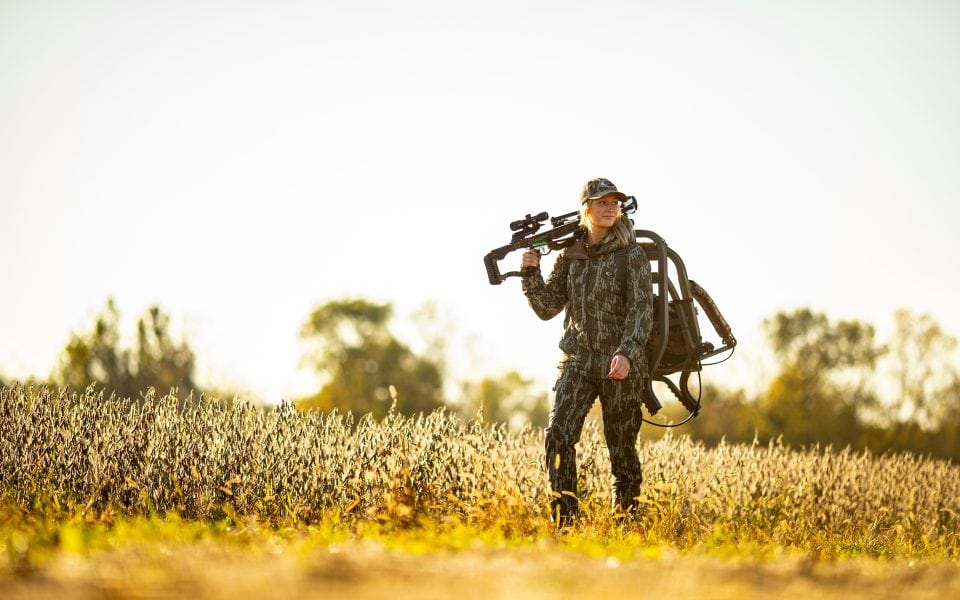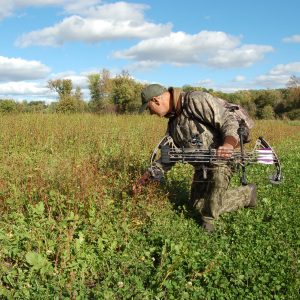Dawn slowly turned to morning, then mid-morning to midday, then midafternoon as I sat in the relative comfort of my partially buried shooting house watching the food plot in front of me. The low cloud cover and near freezing rain kept deer on their feet throughout most of the day but none carried sufficient headgear to generate more than a slightly quickened pulse and a casual second glance though binoculars. Throughout the day I’d seen does and fawns, yearling bucks and a few respectable two year olds; not what I’d come to Ohio for.
I was glassing a pair of almost tempting bucks when one bristled up, staring intently into the timber. Whatever had gotten his attention piqued mine as well. Then it happened; a mature, tall-tined 7 point sauntered confidently into the plot like he owned it, and wasn’t about to tolerate any young upstarts. He was quartering across the far corner and away, and I barely had time to raise my bow, set it on my shooting sticks and blat loudly to stop the deer before he would enter the woods again. He stopped, turned his head and I fired. My shot was true; the bolt found its mark and the deer bolted across the now vacant field before vanishing into the timber and the fading light. It was at that time the biggest deer I’d ever shot and the culmination of something I’d begun more than a decade earlier.
I started hunting with a crossbow long before it was cool, not because it was easier but because it was different. At the time crossbows were still very unpopular and those who used them were ostracized and vilified. It was a risky move, especially for an outdoor writer who specializes in bowhunting, but I felt that crossbows didn’t deserve their bad rap. Work was hard to find at first, and my state bowhunting association literally kicked me out, calling me a shill for the crossbow industry (failing to acknowledge that most of my work still involved compound bows).
Much has changed since then. The transition started slowly, with states like Arkansas, Ohio and Georgia being among the first to allow crossbows during some part of the hunting season. Momentum built and more states allowed crossbows, during gun seasons and by handicapped hunters at first, and then increasingly during any season, including archery. Today, crossbows are legal during archery season in 28 states and during a portion of archery season in 2 more, legal in firearms season in 11 states and illegal hunting equipment in only 1 state: Oregon. The battle to bring crossbows into the mainstream is over, though there are still pockets of resistance.
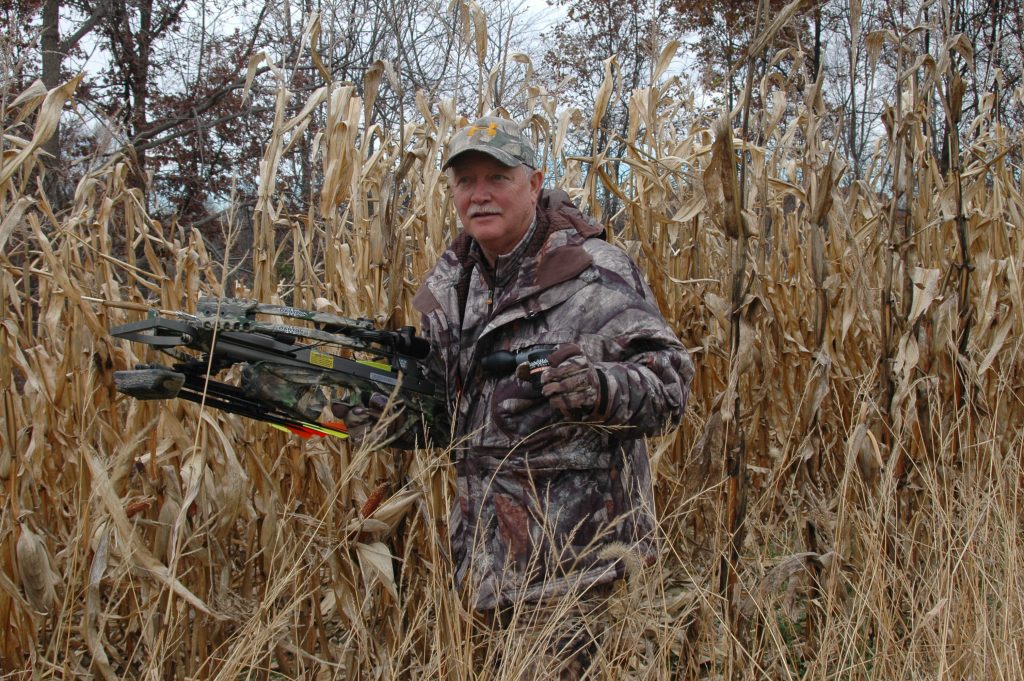
The lingering prejudice against crossbows dates back a long time, and seeking the source can help shed light on solutions. Throughout the Mediaeval Era, much of Europe was in a state of political upheaval and war. Knights mounted on gallant steeds battled amongst themselves with lance and sword. Crossbows were often the weapon of choice for insurgent peasants and mercenaries, and considered an effrontery to the nobility because they could be used by a common foot soldier to fell the upper-class warriors. In 1139, Pope Innocent II issued a judgement against “…the deadly art, hated by God, of crossbowmen…” and it stuck fast.
Though that class distinction has dissolved, some modern elites still stare down their noses at ignoble weapons. That was certainly the case when compound bows first entered the hunting realm, and history repeated itself just a few decades later with crossbows. Some of it can be attributed to human nature and a natural resistance to anything new and different, though one could argue the crossbow is hardly new as it pre-dates the English longbow as a weapon of war. At the risk of offending a few folks there’s also a touch of elitism involved. Some hunters choose the added challenge of archery tackle over modern weaponry, but perhaps should be occasionally reminded that is a personal, voluntary choice. Others choose the most effective, efficient means for legally reducing game to possession. From a wildlife management perspective, the end result is the same: a dead deer. But can one weapon be too effective?
What are Crossbows?
“It’s not a bow,” at least that’s the contention of some crossbow opponents. Let’s take a look. The foundation is a riser – a base to which flexible limbs are attached. Mounted on the distal ends of those limbs are wheels or cams to which strings and cables are attached. When pulled back and released, that string launches an arrow (known as a bolt) fixed with a broadhead. That sounds like a bow to me. Take that bow, turn it on its side and mount it on a stock and it’s still a bow. About the only real difference is that the string can be held at full draw mechanically and indefinitely. One might argue that it’s “fired” by pulling a trigger, but so is the release that I use with my compound bow. Furthermore, there’s no ignition to propel the arrow; so it’s not a gun.
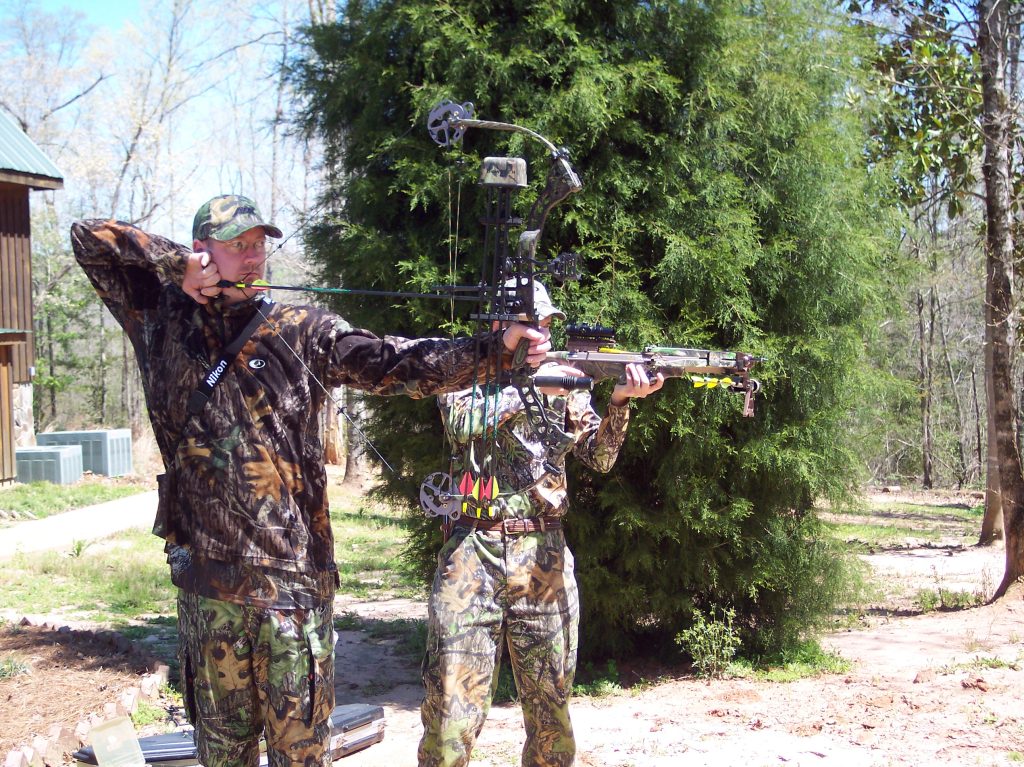
“It’s much more efficient.” Not really. The strongest, fastest crossbows now boast 200 pounds of draw weight, fire arrows at 500 feet per second and impart nearly 200 foot pounds of energy on target. At 350 fps, top end compounds aren’t that far off, and the higher draw weights for crossbows are necessary in order to achieve similar speed and energy with a smaller, heavier shaft. And because it’s heavier, a crossbow arrow drops more quickly downrange.
Crossbow makers now boast accuracy out to 100 yards. That’s true, under controlled conditions like shooting off a solid rest with no wind, and plenty of practice. But a practiced, proficient compound shooter can also hit a target at 100 yards. Shift to a hunting situation with wind, brush and an excited hunter and the playing field becomes more level.
It’s the practice part that’s the biggest difference between crossbows and compounds. The former don’t require nearly as much practice to become proficient. The average hunter can pick one up, sight it in and be reasonably confident of killing a deer within its effective range – about 30 to 40 yards. It takes more practice with a compound but again, that’s a personally imposed limitation. And again, the end result is the same, which is where the bulk of lingering debate lies.
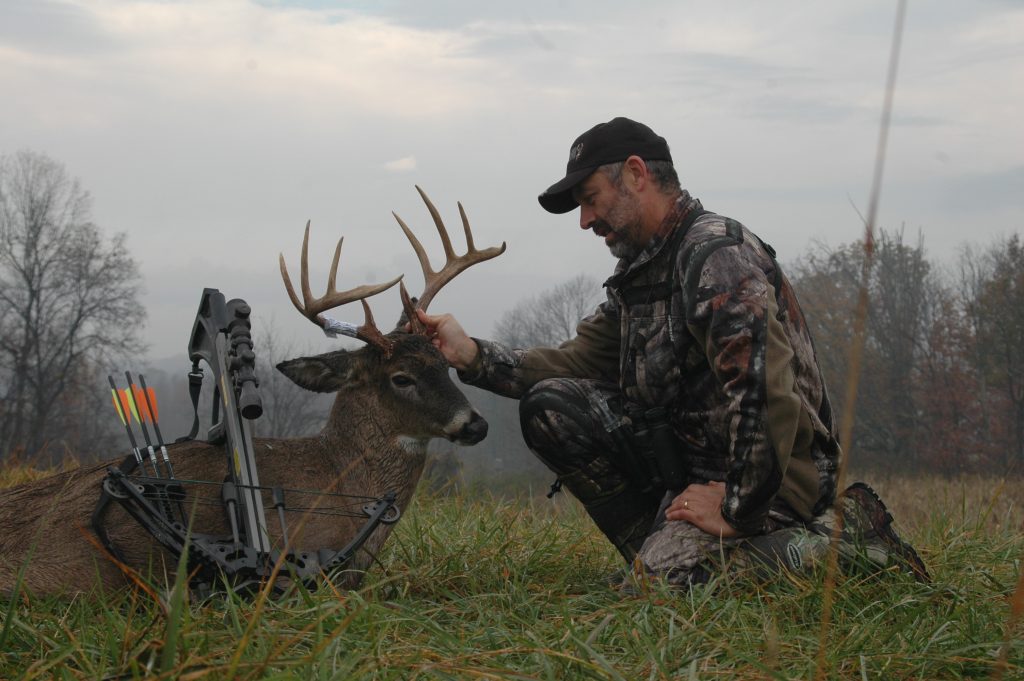
Deer Devastation
The anti-crossbow side contends that because they’re so much easier to learn to use, more hunters are buying and using crossbows, resulting in greater participation (side note: Since when is recruiting, retaining and encouraging more hunters to spend more time in the field a bad thing?) That, in turn has led to higher deer kills during the archery season. Some argue that crossbow hunters are taking opportunity away from compound hunters, while others claim the added pressure and mortality are detrimental to deer herds. Let’s look at a few examples.
Crossbow Hunting in Arkansas
In 1973, crossbows became legal hunting weapons in Arkansas and hunters took 33,794 deer, up from 32,087 the previous year. The deer kill doubled over the next decade and soared to 122,063 in 1993, then to 216,835 in 2020. That total included 103,973 bucks – a 16% increase from the previous year and a 12% increase over the five-year average. Despite almost 50 years of crossbows, the deer herd and the kill keep rising and the population is better balanced. Of the antlered bucks killed, 76% were three or older. Bow hunters (crossbows and conventional bows combined) accounted for 17% of the total deer kill, despite making up more than 50% of Arkansas deer hunters.
Crossbow Hunting in Ohio
When Ohio eliminated crossbow restrictions during its 1982-1983 season, hunters killed 52,885 deer, up from 47,634 deer. By the 1992-93 season, the number of vertical bowhunters had grown from 82,000 to 95,000, while the number of crossbow hunters skyrocketed from 11,000 to 97,000; and all hunters killed 126,113 deer. Steep growth subsided over the next decade with crossbow and vertical bowhunter numbers reaching 106,000 and 88,000, respectively by the 2001-02 season. Bowhunters accounted for 44% of the total 2020 deer kill of 197,720, with 28% of antlered bucks being three or older. Incidentally, success rates for crossbows and longbows (including compounds) in Ohio are both around 15 percent.
Crossbow Hunting in Georgia
When crossbows were legalized in Georgia during the 2002-2003 season, 17,322 crossbow hunters accounted for 4,429 deer (12 percent of the archery harvest). By the 2005-2006 season, the total archery harvest had declined to 30,924 with an estimated 21,454 crossbow hunters accounting for just shy of 20 percent of the archery harvest; and the total kill declined by more than 30,000 since the introduction of crossbows. However, the DNR implemented a management plan in 2005 that called for deer population reductions in five of the state’s nine DMUs, and included extending the firearms season and increasing the antlerless bag limit and the number of either sex hunting days for firearms hunters. Meanwhile, 40% of antlered bucks harvested in 2020 were three or older.
Crossbow Hunting in Virginia
After Virginia allowed crossbows in 2005, hunters killed 214,675 deer including 100,927 antlered bucks, 20,357 button bucks and 93,391 does, a 3% percent decrease from the 2004 season, but 4% greater than the 10-year average. Among archers, vertical bowhunters killed 17,291 deer while crossbow hunters killed 5,476 deer (2.5 percent of the total deer kill). In 2020, Virginia hunters killed 209,356 deer including 114,759 antlered males and 185,308 antlerless deer. Bowhunters (including crossbows) now account for 14% of Virginia’s total deer kill, with 38% of antlered bucks being three or older.
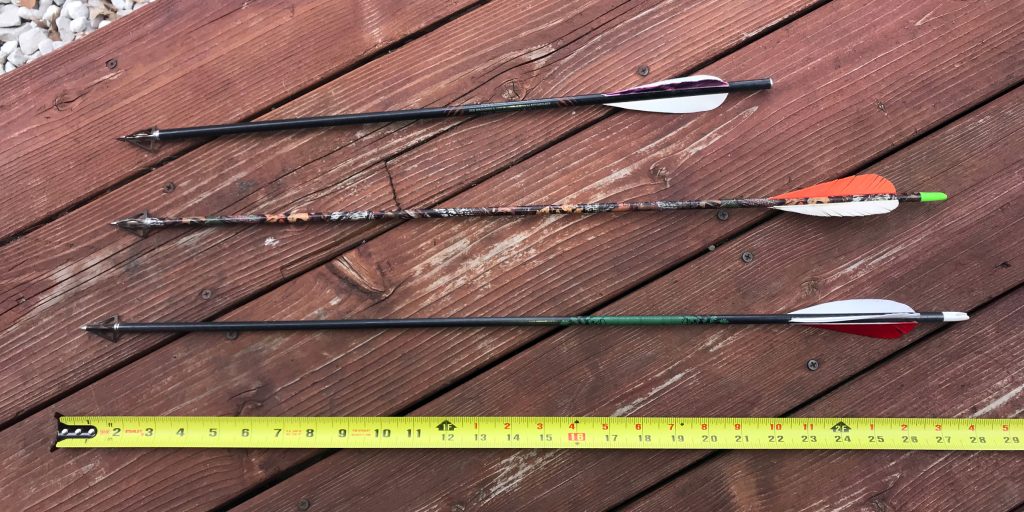
Crossbow Hunting in Pennsylvania
In 2008, the year before crossbow use was expanded for all hunters during the archery season, Pennsylvania hunters killed 335,850 deer. The following year’s kill was down by nearly 30,000. Meanwhile, the overall archery kill increased from 14% of the total harvest in 2007-08 to 20% in 2010-11; and the crossbow’s proportion of the archery harvest rose from 15% in 2007-08 and 2008-09 to 30% in 2009-10 and 34% in 2010-11. However, biologists concluded that the slight increase in deer harvest since the addition of crossbows was not unsustainable or counter to the agency’s management objectives. In 2020, Pennsylvanians killed 435,180 deer. Bowhunters accounted for 37% of that, and only 18% of antlered bucks were yearlings.
Crossbow Hunting in Kansas
Prior to permitting crossbows during the archery season in 2013, Kansas hunters killed around 98,000 deer, with bowhunters accounting for about 25%. The total kill dropped by nearly 10,000 during the first year of crossbow hunting but the bow kill rose by approximately 6,000 accounting for 34 percent of the total. In 2014, the total kill climbed to 91,500 with bowhunters taking a similar 35 percent. The 2020 deer harvest was 83,126 deer with bowhunters contribution up to 40%. Meanwhile, biologists have identified the cumulative effects of drought and hemorrhagic disease as the primary causes for the decline in deer populations.
Crossbow Hunting in Wisconsin
The following year Wisconsin legalized crossbows and the 47,449 hunters who purchased a crossbow authority helped contribute to a total kill of 342,631 and a record buck bow kill of 46,201. In 2020, Wisconsin hunters killed 339,901 deer, including 158,236 antlered bucks, with bowhunters being responsible for 34% of the total kill. DNR authorities considered the impact of crossbows to be minimal.
Crossbow Hunting in Michigan
The proportion of bowhunters using crossbows increased from 19 to 37 then to 49 percent, respectively over the first three years they were allowed in Michigan. Despite this, the overall annual deer harvest has remained consistently over 400,000 with bowhunters accounting for around 33%. In 2020, Michigan ranked second in terms of total antlered buck harvest and antlered buck harvest per square mile, third in antlerless harvest and fifth in antlerless harvest per square mile.
While the addition of crossbows and crossbow hunters has undoubtedly contributed to increased deer harvests in some cases, there doesn’t seem to be much, if any evidence to suggest there’s a problem, at least in terms of deer management. Trying to identify cause and effect becomes even more difficult when considering mitigating factors like changes in management strategy, outbreaks of HD and the spread of CWD.
Crossbow Hunting in Ohio
Ohio has allowed the use of crossbows during archery season since 1982. According to records from the Boone and Crockett and Pope and Young clubs, Ohio ranks fourth in the nation in terms of trophy whitetail entries. The largest deer taken in North America in 1999 was shot in Ohio; and the third-largest taken in 2000 was shot in Ohio, the same year Mike Beatty arrowed what was at that time the largest buck ever taken by a hunter. The Buckeye Big Buck Club recognized 716 whitetails (with a score of 140 inches or more) at its March 2004 banquet. Of those, 37 qualified for the B&C record books, including 11 that scored over 200 inches.
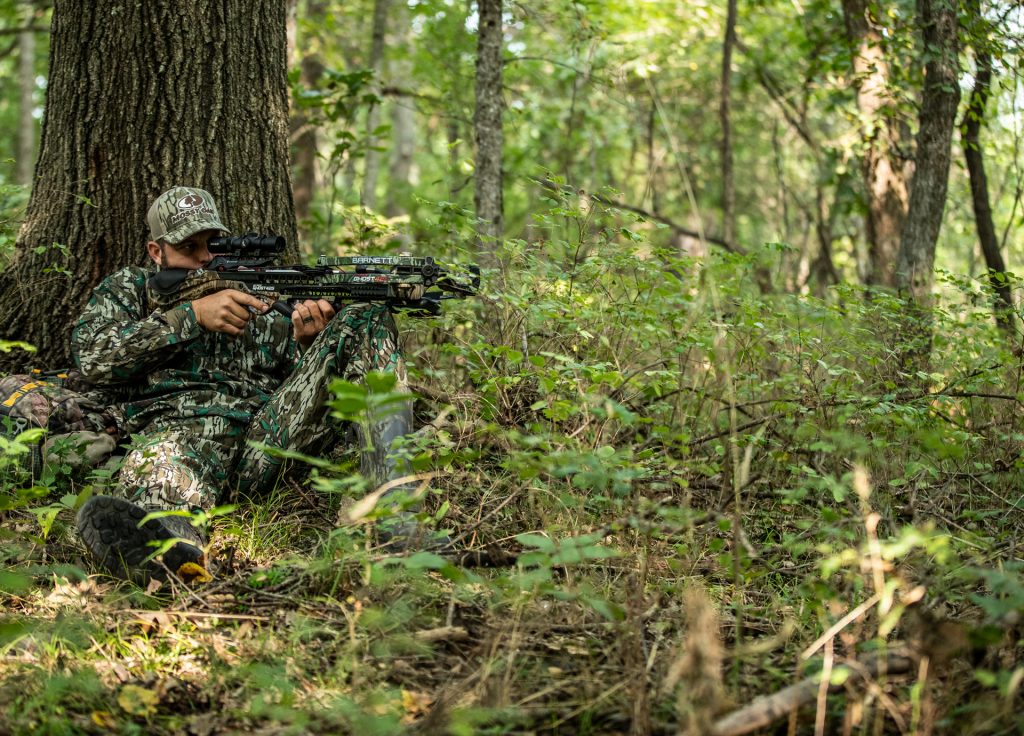
So What’s the Problem with Crossbow Hunting?
One of the first things I was taught as a young wildlife biology student is that wildlife management ultimately comes down to people management. Deer, and all game are a finite resource. With proper management there should always be a harvestable surplus, the removal of which will not detract from population health. It then becomes a matter of how to apportion that surplus to various special interest groups like gun hunters and bow hunters, meat hunters and trophy hunters. After all, they’re footing the bill for wildlife conservation.
In sports, the most consistently successful teams are those that emphasize team play over personal accomplishments. Perhaps we should take a lesson and remember we’re all on the same team. Overall hunter numbers are flat or declining, depending on which source you consult, and the hunting population is aging. After-school sports, single-working-parent families and computer and video games make it harder to engage youths. Meanwhile, veteran hunters are aging out, or leaving the sport due to lack of access or a quality hunting experience.
Studies from several states like Ohio and Wisconsin have shown the value of crossbows in recruiting younger hunters and retaining older ones. More specifically, they found crossbows represented a more effective way of getting kids involved in bowhunting. After a certain age, some shifted to compound bows. They also found the opposite trend in older hunters, with some seniors switching from compounds to crossbows rather than abandoning archery due to physical limitations. Meanwhile, crossbows represent an archery alternative for those of any age who are physically incapable of shooting a compound or a recurve. Oh, and in terms of equipment sales, the only segment of the archery industry showing significant growth right now is crossbows.
Conclusion
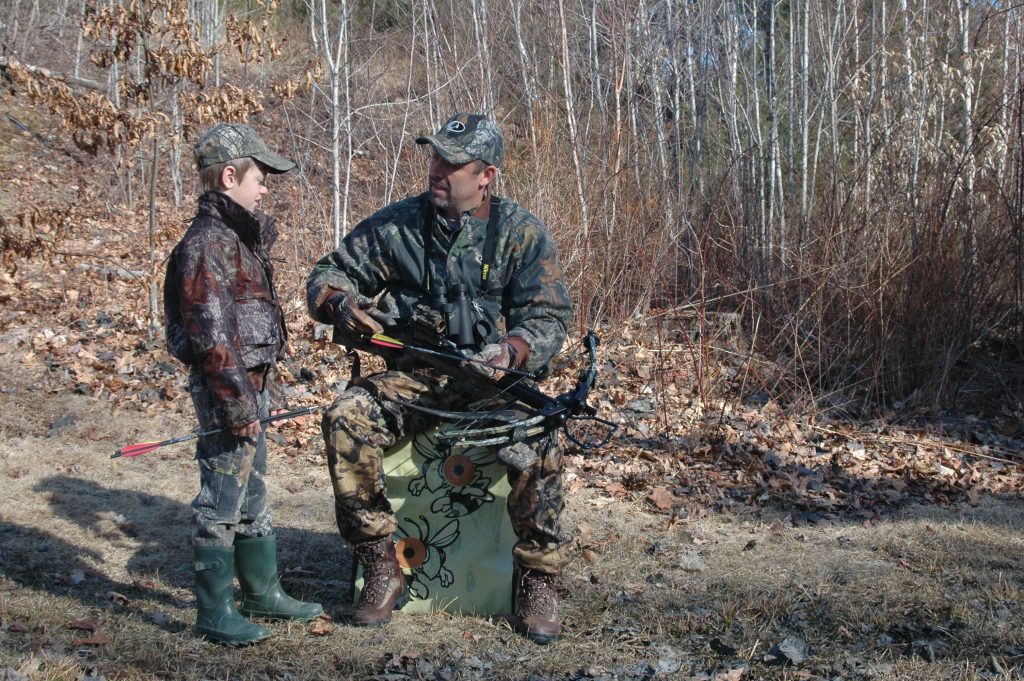
Over two decades ago the state where I live implemented an expanded archery season designed to increase hunting opportunity and reduce deer numbers in areas where firearms hunting was unsafe or impractical, and deer harvest objectives were not being met. I welcomed the opportunity at first, especially in a state with a previous annual bag limit of one deer. Interest in bowhunting rose dramatically but one by one I got crowded out of my favorite hunting haunts. I expect a lot of conventional bowhunters are experiencing the same thing where more gun hunters and new hunters are taking advantage of increasing crossbow hunting opportunities, and you can’t blame them for complaining. However, at least in my case and apparently in many others, the deer herd is still just as strong.

